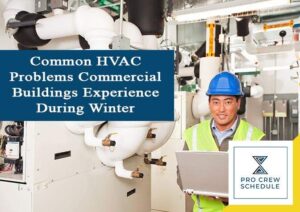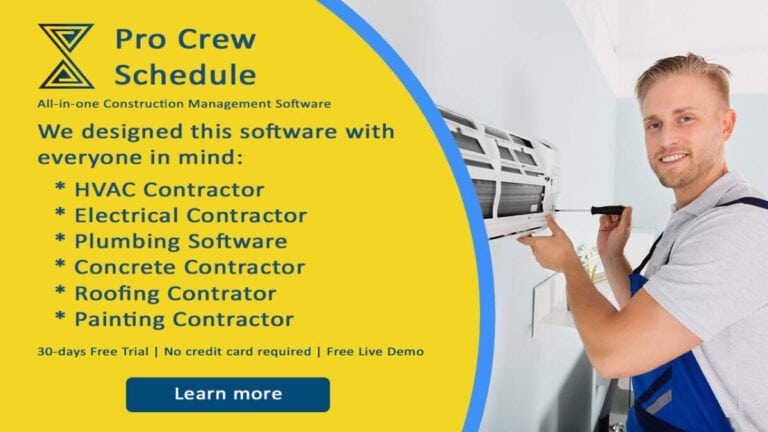The winter season is a double-edged sword for workers in the HVAC trade. On the one hand, it’s a peak season where the business is booming. On the other, the exceptionally high volume of repair calls and amount of jobs can be overwhelming– and that’s on top of other projects like working on commercial construction and the types of contracts.
Managing construction projects or trade jobs isn’t as easy, either. With the number of employees under them and the number of incoming jobs, a contractor must create a clean and organized construction schedule.
Even though having the right HVAC or construction tools helps tremendously, the winter season is still a very stressful time for HVAC tradespeople. But, there are things you can do to make things easier. For one, you have to be prepared to handle anything. That means being educated and informed about the ins and outs of the trade, as well as knowing how to apply your trade skills.
So, to help all you HVAC tradespeople during this season, here are the common commercial HVAC problems you should expect this winter; plus, some winterizing tips you can tell your clients.
Common HVAC Problems In The Winter
1. Uneven heating in the building
It’s more important than ever to have consistent and even heating throughout the building during the colder months. But because of the extreme cold, it’s easily noticeable when different rooms carry different temperatures.
When this happens, it’s usually because the air vents are blocked. So, the first and simplest thing to do is check for items blocking the airflow into the room, like furniture and other decors.
In other cases, holes and cracks in the air ducks can cause a commercial building to experience uneven heating. It may be a good idea to insulate air ducts if set along external walls or unheated areas.
2. Poor air quality
Building managers usually close and seal the building so that the outside’s cold won’t enter and the heat from the inside does not escape. But when they do this, the air quality inside drops because dirt, dust, and– if pets are allowed inside– dander accumulate, causing allergy symptoms.
As the name suggests, air filters improve air quality by catching dirt, dust, and other airborne particles. As a preventative measure, tell your clients to have the system’s air filters changed once every month. On the same note, because this is particularly vital if pets and tobacco smoking are allowed in the building, the ideal time to check and change filters is every two weeks.
But suppose the air quality continues to decrease despite regularly changing the filters. In that case, there could be a problem in the ducts, perhaps growing mold or mildew, or dust and pet dander got in. with this, you would have to clean the system’s air ducts and seal them, removing all dirt and allergens.
On the other hand, if the indoor air quality still is not up to par, the whole system might not be operating correctly. Because the heating system will be working overtime during the colder months, there is a chance it could malfunction. The best preventative measure and solution to this is to urge your clients to have it checked and fixed by an HVAC professional.
3. Frozen pipes
An overlap between plumbing and HVAC systems consists of pipes that can freeze in temperatures below 32 degrees. This can happen to hydronic heating systems, water heaters, and water and steam boilers. When pipes freeze, they can burst and lead to severe water damage in the building.
If you come across a frozen pipe/s during an inspection or get a call about a suspected one, the first thing to do is turn off the water supply. Then, slowly thaw it out, maybe with a hairdryer, space heater, or thermostatically controlled heat tape. If you only spot a leak, you can patch it up, but it’s best just to replace the pipe to prevent further damage.
4. Furnace blowing cold air through ducts
When HVAC systems blow out cold air at the beginning of the heating season, it’s usually because of a wrongly set thermostat. So, when you get a call about cold air blowing through the ducts, tell the customer to check their thermostat heating settings if they are correctly programmed.
If it is already set to heat and correct temperatures are input, the customer might have a problem with the thermostat sensor. If not, the issue might lie within coils or heating elements, a blown pilot light, broken ignitions, defective gas valves, faulty thermocouples, or an overheating system.
Once you do an inspection, you can properly diagnose the problem and work your way from there.
5. Malfunctioning thermostats
Thermostats are responsible for telling the HVAC system to turn on and off. Thermostats today say to the heating system to activate and increase the amount of warm air. It also means it shuts off or lowers the heat output when the target or ideal temperature has been reached. But when thermostats encounter issues, like worn-out/dirty sensors or being completely broken, other indoor climate issues can arise.
When dealing with outdated thermostats in commercial buildings or big residential ones, it’s better to replace and upgrade them to smart ones. The building occupants can easily program and control the heat output with newer ones.
6. The system suddenly shuts down.
Because of it being used longer and harder, commercial building HVAC systems experience a lot of wear and strain during the winter season. This, in turn, can cause the system to shut down suddenly.
The best way to fix this is to prevent it. Building owners and managers must be informed of the importance of regular preventative maintenance by a professional.
HVAC Winter Tips For Commercial Buildings
Another way you can alleviate the winter season’s stress is to lessen the number of HVAC problems occurring by preventing them. One of the best and most efficient ways to do this is to give your clients tips on making their commercial systems survive the winter.
1. “Schedule a professional to inspect the system fully.”
Throughout most of our HVAC articles, we have reiterated time and time the importance of regular maintenance and inspection by a professional. But it especially crucial for the colder months.
There may have been a few small problems already occurring, but it could mean trouble in the winter if they are not looked at immediately. When a professional HVAC technician, such as yourself, inspects the system, they can identify these smaller issues and fix them before becoming too big to handle.
2. “Have a preventative maintenance plan.”
After you check the system for potential problems, you can work with the client to create a regular preventative maintenance plan. On your part, repair or replace what needs repairing or replacing, such as leaks in pipes and defective components. You can also suggest investing in upgrading their equipment to more durable and better-performing ones. The new equipment will not only perform better despite the cold, but the advances in technology will also help them conserve energy and save on their monthly bills.
You can then educate your customer on what they can do to continue maintaining their system throughout the winter.
3. “Calibrate your thermostats to save energy.”
HVAC systems are some of the biggest consumers of electricity, which, in turn, means higher bills. Although most are digital now, older ones may not be in sync and are not as efficient, simultaneously activating heating and cooling.
So, when temperatures start to drop, urge your clients to have professionals check on their thermostats. Having it professionally calibrated prevents simultaneous heating and cooling, plus it saves them money on energy.
You can also suggest installing a smart and programmable one if they haven’t already. With a web- and cloud-based system, they can maintain settings and remotely control the indoor climate.
4. “Replace all filters and clean heating ducts.”
Since air filters are responsible for catching and trapping dirt and dust, they always need to be clean to keep the airflow quality up. If not, they should immediately be replaced, ideally once every month. Buildings that allow smoking and pets should check and replace filters every two weeks.
Neglecting to check and change filters would affect the air quality and increase the cost of running the system. This is because compressors and fans will undergo a significant amount of wear and tear as they struggle to work through filthy filters.
5. “Make sure economizers are okay to give ‘free cooling.’”
HVAC systems for commercial buildings usually have an economizer. This component lets the building use air from the outside to cool the building when that air hits the proper temperature and humidity. However, this “free cooling” component can be negatively affected by extreme environmental factors. So, they should be checked before winter hits.
This is why you need contractor software (especially during winter)
Using management software is excellent at any time of the year. But it’s beneficial during the winter. With the high volume of job orders and humans’ limited capabilities, management software can lighten the load and help keep things organized.
Pro Crew Schedule’s HVAC contractor software is cloud-based and completely mobile, which means you can remotely work with your techs wherever you are. With the scheduling feature, you can send the right job order and your techs can immediately be dispatched to tend to the customers. With the time-in/time-out feature, you can keep track of them and simplify accounting. More than that, essential documents can be saved and shared, guaranteeing efficiency and customer satisfaction.







